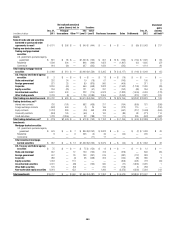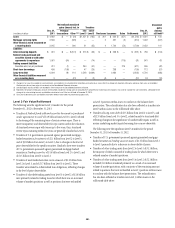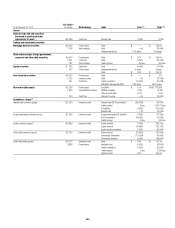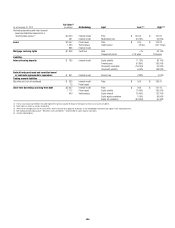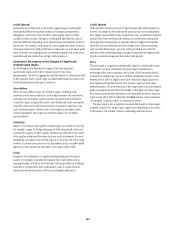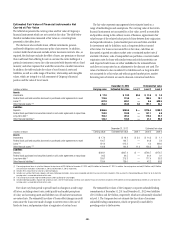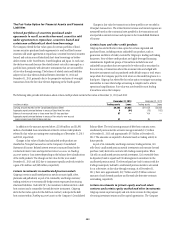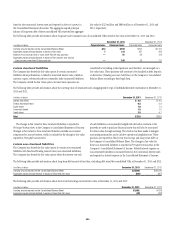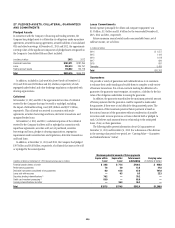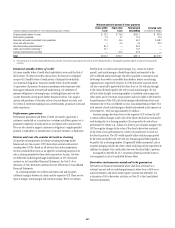Citibank 2013 Annual Report Download - page 305
Download and view the complete annual report
Please find page 305 of the 2013 Citibank annual report below. You can navigate through the pages in the report by either clicking on the pages listed below, or by using the keyword search tool below to find specific information within the annual report.287
Sensitivity to Unobservable Inputs and Interrelationships
between Unobservable Inputs
The impact of key unobservable inputs on the Level 3 fair value
measurements may not be independent of one another. In addition, the
amount and direction of the impact on a fair value measurement for a given
change in an unobservable input depends on the nature of the instrument as
well as whether the Company holds the instrument as an asset or a liability.
For certain instruments, the pricing hedging and risk management are
sensitive to the correlation between various inputs rather than on the analysis
and aggregation of the individual inputs.
The following section describes the sensitivities and interrelationships of
the most significant unobservable inputs used by the Company in Level 3 fair
value measurements.
Correlation
Correlation is a measure of the co-movement between two or more variables.
A variety of correlation-related assumptions are required for a wide range of
instruments, including equity and credit baskets, foreign-exchange options,
CDOs backed by loans or bonds, mortgages, subprime mortgages and many
other instruments. For almost all of these instruments, correlations are not
observable in the market and must be estimated using historical information.
Estimating correlation can be especially difficult where it may vary over time.
Extracting correlation information from market data requires significant
assumptions regarding the informational efficiency of the market (for
example, swaption markets). Changes in correlation levels can have a major
impact, favorable or unfavorable, on the value of an instrument, depending
on its nature. A change in the default correlation of the fair value of the
underlying bonds comprising a CDO structure would affect the fair value of
the senior tranche. For example, an increase in the default correlation of the
underlying bonds would reduce the fair value of the senior tranche, because
highly correlated instruments produce larger losses in the event of default
and a part of these losses would become attributable to the senior tranche.
That same change in default correlation would have a different impact on
junior tranches of the same structure.
Volatility
Volatility represents the speed and severity of market price changes and is
a key factor in pricing options. Typically, instruments can become more
expensive if volatility increases. For example, as an index becomes more
volatile, the cost to Citi of maintaining a given level of exposure increases
because more frequent rebalancing of the portfolio is required. Volatility
generally depends on the tenor of the underlying instrument and the strike
price or level defined in the contract. Volatilities for certain combinations
of tenor and strike are not observable. The general relationship between
changes in the value of a portfolio to changes in volatility also depends on
changes in interest rates and the level of the underlying index. Generally,
long option positions (assets) benefit from increases in volatility, whereas
short option positions (liabilities) will suffer losses. Some instruments are
more sensitive to changes in volatility than others. For example, an at-the-
money option would experience a larger percentage change in its fair value
than a deep-in-the-money option. In addition, the fair value of an option
with more than one underlying security (for example, an option on a basket
of bonds) depends on the volatility of the individual underlying securities as
well as their correlations.
Yield
Adjusted yield is generally used to discount the projected future principal and
interest cash flows on instruments, such as asset-backed securities. Adjusted
yield is impacted by changes in the interest rate environment and relevant
credit spreads.
In some circumstances, the yield of an instrument is not observable in
the market and must be estimated from historical data or from yields of
similar securities. This estimated yield may need to be adjusted to capture the
characteristics of the security being valued. In other situations, the estimated
yield may not represent sufficient market liquidity and must be adjusted as
well. Whenever the amount of the adjustment is significant to the value of
the security, the fair value measurement is classified as Level 3.
Prepayment
Voluntary unscheduled payments (prepayments) change the future cash
flows for the investor and thereby change the fair value of the security. The
effect of prepayments is more pronounced for residential mortgage-backed
securities. An increase in prepayments—in speed or magnitude—generally
creates losses for the holder of these securities. Prepayment is generally
negatively correlated with delinquency and interest rate. A combination
of low prepayment and high delinquencies amplify each input’s negative
impact on mortgage securities’ valuation. As prepayment speeds change, the
weighted average life of the security changes, which impacts the valuation
either positively or negatively, depending upon the nature of the security and
the direction of the change in the weighted average life.
Recovery
Recovery is the proportion of the total outstanding balance of a bond or loan
that is expected to be collected in a liquidation scenario. For many credit
securities (such as asset-backed securities), there is no directly observable
market input for recovery, but indications of recovery levels are available
from pricing services. The assumed recovery of a security may differ from
its actual recovery that will be observable in the future. The recovery rate
impacts the valuation of credit securities. Generally, an increase in the
recovery rate assumption increases the fair value of the security. An increase
in loss severity, the inverse of the recovery rate, reduces the amount of
principal available for distribution and, as a result, decreases the fair value of
the security.





